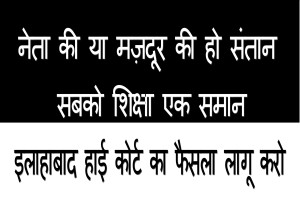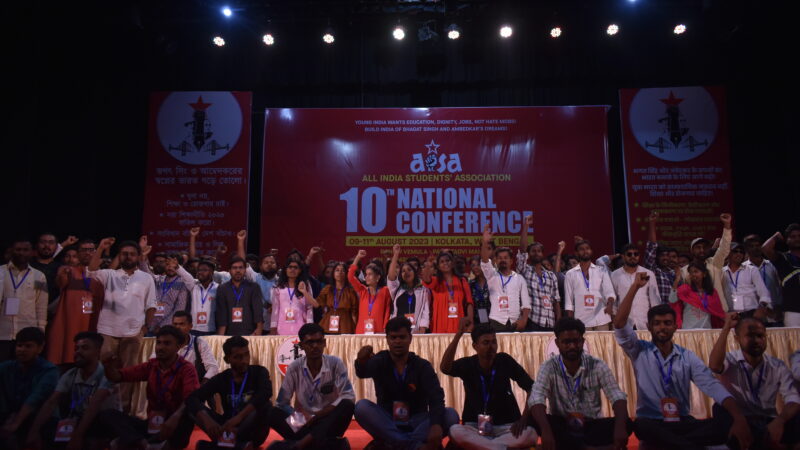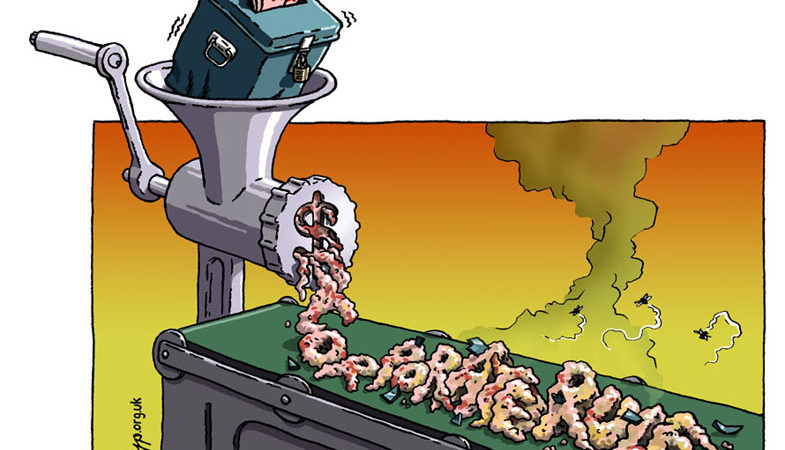Uphold the Landmark Verdict by the Allahabad High Court on Schooling!
 AISA welcomes the historic and landmark verdict by the Allahabad High Court directing the chief secretary to ensure that children/wards of government officials/servants, those serving in the local bodies, representatives of people and judiciary, etc., are sent to state run primary schools. The judgement took cognizance of the pathetic situation of the state run primary schools and observed that it was important that the aforementioned section sent their children or wards to the state run schools, since –“Only then would they be serious enough to look into the requirements of these schools and ensure that they are run in good condition”.
AISA welcomes the historic and landmark verdict by the Allahabad High Court directing the chief secretary to ensure that children/wards of government officials/servants, those serving in the local bodies, representatives of people and judiciary, etc., are sent to state run primary schools. The judgement took cognizance of the pathetic situation of the state run primary schools and observed that it was important that the aforementioned section sent their children or wards to the state run schools, since –“Only then would they be serious enough to look into the requirements of these schools and ensure that they are run in good condition”.
The court also took cognizance of the unequal schooling system that exists in the country and in this case, the state of Uttar Pradesh, as a result of which the quality schools are accessible only to the affluent sections that can afford the high cost of these schools whereas the majority of the masses are forced to send their children to sub-standard Board schools that lack sufficient infrastructure. Sudhir Agarawal, the single judge who gave the verdict noted that –
“Today, judicial cognizance can be taken of the fact that there are three categories of Primary Schools running in the State of U.P., imparting education to minor children of this State. One of such categories, which is catering to the need of almost 90 per cent of the population of minor children are run by Board and in the most shabby conditions.
- There are a very few number of Primary Schools run by elite and highly privileged category of people which are branded public schools.Some English/Convent Schools are run by Christian minority wherein children of poor and lower-middle class have virtually negligible scope. This category of Schools basically cater to the need of highly rich people, high class Bureaucrats, Ministers, peoples’ representatives, like, Members of Parliament, Members of Legislative Assemblies and high-middle class people. The wards of a limited class of elite society can get education therein.Most of the people cannot meet even financial standards of fees. Admission standards are very strict and mostly available due to high resources. These Schools have best kind of infrastructures, tutorial staff and all other facilities. These Schools can be termed as ‘Elite Schools’.”
The excerpt from the judgment is a particularly relevant as it voices the concern of political and social activists who have been fighting for an egalitarian education system that guarantees quality education to all without discriminating on socio-economic basis. A common school system based on the principles of neighbourhood schooling where all schools offer similar quality of education in terms of training of teachers, infrastructure, student-teacher ratio, student centred pedagogy, and an updated curriculum that is sensitive to pluralities and can be accessed in children’s own languages, has been a long standing demand of those who envision quality education as an unquestionable right of every child.
Unfortunately, for long our school education system has operated as a multiple tier system where quality comes only at a price. At different locations on the tier are not just the private and the public schools, but within the government run public schools also, there are variations as far as the quality is concerned.
The Right to Free and Compulsory Education Act (2009), despite its pretentious claims, came as massive disappointment to all as it not only failed to make quality school education till class XII a right of every child, but it also failed to address the unbridgeable gap between quality of high cost private schools and low cost government run schools. Further, it kept some of the better run government schools like the KVs, Sainik Schools and the Navodya Vidyalaya’s out of the ambit of the RTE.
Several activists and forums such as the AIFRTE have struggled for last one decade with the slogan “Neta ki ya mazdoor ki ho santaan, sabko shiksha ek saman”. AISA for long has been in the forefront of all such struggles to ensure that quality schooling be a right of every child. AISA has also stood in solidarity with all struggling forces who have fought for Right to Education, where education is not narrowly interpreted as a limited period entry to the lowest rung of badly run government schools. An entry into a primary school where one or two teachers (often ill trained and under qualified) are expected to teach students of at least five grades, while simultaneously handling several other responsibilities including that of the preparation of everyday mid-day meal and participation in various election and census related works, by no means serves the purpose of quality education to all.
In this context, the Allahabad Court judgment assumes significance for the implications it holds not only for schools in UP but for schools across states. The conditions of the government run schools does not come as surprise, and the judgment insightfully notes that as long as those responsible for the running of these schools do not send their own children to them, no worthwhile change can be expected-
“It is not difficult to understand, why conditions of these Schools has not improved. The reason is quite obvious and simple, though the State Government is not able to see. There is no real involvement of administration with these Schools. Any person who has some capacity and adequate finances, sends his child/children in Elite and Semi-Elite Primary School. They do not even think of sending their wards for primary education to Schools run and managed by Board. Whether it is the District Collector or Police Chief in the District or any other Government Servant, they ensure that their children should get primary education in Primary Schools having better infrastructure and other facilities which obviously belong to first and second categories of Primary Schools, as noted above and completely exclude third category Schools, i.e. Common-men’s Schools. The public administration therefore has no actual indulgence to see functioning and requirements of these schools. These schools have become a mode of earning political mileage instead of real catering to its need”.
It is not surprising that several from these ‘elite’ and ‘semi-elite’ sections have criticized the judgment as a case of ‘Judicial Over-reach’. Given that for long these sections have ensured that quality education remains a commodity for sale that they alone have the resources to purchase, they are likely to engage in nefarious attempts to ensure that implementation of the directive is met by obstacles.
In such a context, AISA appeals to all to unite to ensure that pressure is built on the UP and other state governments as well to act according to the verdict and also to remain vigilant towards attempts to scuttle the same.





